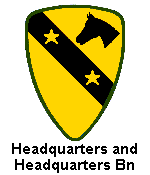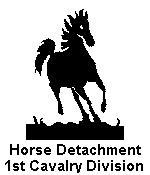|
1970
1st Lt. Dack convinced the commander of the 1st Armored Division, MG
Desobry. to allow a horse mounted color guard. The III Corps
Commander, LTG B. E. Powell, and the Army Vice Chief, LTG Palmer
agreed to allow the unit as a no cost recruiting tool for the 1st
Armored Division.
1971
The 1st Armored Division is redesignated the 1st Cavalry Division. The
1st Cavalry Division Association was solicited for money, equipment and
sponsorship. (May)
1971
The 1st Cavalry Division Association voted to sponsor the formation of
a horse platoon with the III Corps Commander's approval. (August)
1971
The first of ten horses was procured as a transfer of government
property from the Army Pentathion Team at San Antonio, Texas. Eight
troopers were assigned from within the Division. (December)
1972
The Horse Platoon was officially established as a Unit-Of-Choice
recruiting tool sponsored by The 1st Cavalry Division Association. The
Unit received $2,000 of unqualified denotations from the 1st Cavalry
Division Association and $2,500 from the Killeen Chamber of Commerce
for the purchase of show saddles, Weapons and bridles. One eight-horse
trailer was denoted and rebuilt. Feed was purchased by the troopers at
a cost of about $15 to $25 a month. This continued until the Hunt and
Saddle Club began to purchase feed from the platoon to help off-set
the cost. Uniforms were first purchased by the troopers from whatever
sources were available. (January)
1972
The first show, a parade, was performed in San Angelo, Texas. Although
it was only a parade, this laid the foundation for public appearances.
(April)
1972
Throughout the year, donations were received which enabled the
purchase of eight additional horses. Units of the 1st Cavalry Division
Association donated money to purchase horses in that unit's name.
(December)
1973
The first two mules and an M1879 Escort Wagon was denoted.
1974
The first mounted cavalry demonstration was conducted using six riders
and mounts.
1975
The M1878 Escort Wagon was added to the demonstrations, using a two
mule team. Prior to this event, the wagon was only used for
parades.
1976
The first mounted cavalry demonstration using eight riders and Mounts.
Two of the box trailers were declared unsafe. Trailers had to be
borrowed for the transportation of the horses to and from the
shows.
1976
The horse Platoon was recognized by FORSCOM when the III Corps
Commander accepted responsibility for the Unit and approved an
unconditional denotation of equipment from the 1st Cavalry Division
Association to III Corps. All operating costs are now paid by the
installation. (December)
1980
The 1st Cavalry Hortse Platoon is recognized as a Special Ceremonial
Unit (SCU) by the department of the Army, UP AR 310-34. The Department
of the Army allows government expense travel to be paid from
discretionary funds. From now until 1987, denotations an purchases are
the source of all horses and equipment. (May)
1981
The first requirement budget is established and funding is provided as
if the Horse Platoon were an installation Unit.
1982
Two twelve horse trailers are purchased at a cost of $19,000 each.
1983
Soldiers are now assigned to the Horse Platoon full time and permanent
spaces are provided from within the 1st Cavalry Division. A tack van
is procured from the Property Book Office (PBO). (April)
1984
The civilian position of Equestrain Training Instructor and Stable
Master is established for the Horse Platoon. This position was first
held by LTC Thomas B. Larkin (Ret)
1985
All tack, up to this point of time, has been unconditionally denoted.
Purchase of equipment is now allowed.
1986
The first independent Horse Platoon Command Operating Budget is
approved by the Installation Commander, LTG Saint, to be funded
through III Corps G3/PTM. Two additional mules were added to bring the
total to four. The first mounted cavalry demonstration using eleven
riders and mounts and a four mule team to pull the M1878 Escort Wagon
was conducted.
1986
The Horse Platoon was redesignated as the Horse Cavalry Detachment
(HCD) to better conform to historical precedent. (December)
1987
Changing tax laws no longer allowed for total deducted denotations of
the market value of the animals. While the animals are still
occasionally denoted, government purchase now becomes a major source
of acquisition. A second wagon was built by the detachment to the
original 1878 specifications.
1989
MG Streeter, 1st cavalry Division Commander, authorizes the Horse
Cavalry Detachment to maintain animal strength of 44 horses and 8
mules. An M1841 Light Mountain Howitzer is procured and fired by the
US Cavalry for the first time in over 100 years. The first mounted
cavalry demonstrations, using 15 riders and mounts was conducted.
However this was an exception, the demonstration strength was soon cut
back to thr today's standard of 11 riders and mounts.
1990
The Horse Cavalry Detachment troop strength authorization is increased
to 1 officer and 32 enlisted Men with the addition of a cannoneer
positions.
1991
One four-horse trailer is purchased for emergency situations.
1991
On 05 June, SGT Bucky, the last of the donated horses was put to rest.
SGT Bucky, serving since 1973, had been purchased with funds provided
by the 8th Engineers. (June)
1992
A one-ton dual wheel pick-up truck was purchased by TMP to pull the
Escort Wagon trailer.
1993
The Farrier Shop was constructed by the 62nd Engineer Battalion
1995
Horse Cavalry Detachment troopers are no longer assigned as special
duty (SD) status. The 1st Cavalry Division REG 611-200 authorized
Horse Cavalry Detachment to be assigned as permanent duty individuals.
(September)
1995
A new training area was constructed by The Horse Cavalry Detachment
personnel. (August)
1995
Ulyses S. "Grant", the first miniature mule to serve in the 1st
Cavalry Horse Detachment was laid to rest. He was donated in 1989 by
Master Troiy Allen of South Dakota. (06 December)
1996
The Horse Cavalry Detachment participated in the Pasadena, California
Tournament of Roses Parade. (January)
| 


![]()



![]()
![]() Today the Force Structure and Unit History Branch continues the work begun by
the Historical Section of the Army War College. The branch maintains
historical information on active and inactive units in all components -
Regular Army, Army Reserve, and Army National Guard, and prepares official
Lineage and Honors Certificates. On the basis of research in primary and
secondary material, the certificates outline the major organizational changes
undergone by the unit and provide a list of the official battle honors
(campaign credit and decorations) that the unit has earned. The information
contained on the certificates is reformatted for publication in the Army
Lineage Series
Today the Force Structure and Unit History Branch continues the work begun by
the Historical Section of the Army War College. The branch maintains
historical information on active and inactive units in all components -
Regular Army, Army Reserve, and Army National Guard, and prepares official
Lineage and Honors Certificates. On the basis of research in primary and
secondary material, the certificates outline the major organizational changes
undergone by the unit and provide a list of the official battle honors
(campaign credit and decorations) that the unit has earned. The information
contained on the certificates is reformatted for publication in the Army
Lineage Series



![]() The history of the 1st Cavalry Division Horse Cavalry Detachment recorded the
following significant events occurring on the dates listed.
The history of the 1st Cavalry Division Horse Cavalry Detachment recorded the
following significant events occurring on the dates listed.









![]() eMail Your WebSite Comments.
eMail Your WebSite Comments.
![]()
![]()
![]() Return to "MyOwnPages"©.
Return to "MyOwnPages"©.
![]()